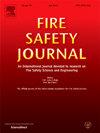Separation of heat transfer modes in fire: Review and analysis
IF 3.4
3区 工程技术
Q2 ENGINEERING, CIVIL
引用次数: 0
Abstract
The local heat transfer to a fire-exposed surface consists of radiative and convective components. Computational fluid dynamics fire models independently predict each of these heat transfer modes. However, experimental measurements of heat transfer are typically limited to measurements of the total heat transfer rather than the separation of individual components. As a result, it can be difficult to identify whether total heat transfer discrepancies between models and experiments are due to errors in convective and/or radiative heat transfer. Several different approaches have been presented over the years to separate the total measured heat transfer into its individual components. Each method comes with its own assumptions, limitations, and uncertainties.
This paper provides a review of the existing literature on this topic which is augmented with engineering analysis. Previous studies are summarized, the mathematical formulations in each method are presented, and the uncertainties associated with the assumptions are discussed. These results are then used to estimate the expanded uncertainty associated with each approach. Under ideal conditions, the uncertainty of the separated heat transfer modes are approximately 15% of the total heat flux. Under less ideal conditions this uncertainty is higher. General recommendations to reduce these uncertainties in future studies are provided.

火灾中热传递模式的分离:回顾与分析
火灾暴露表面的局部热传递由辐射和对流两部分组成。计算流体动力学火灾模型独立地预测这些传热模式。然而,传热的实验测量通常局限于总传热的测量,而不是单个组分的分离。因此,很难确定模型和实验之间的总传热差异是否是由于对流和/或辐射传热的误差造成的。多年来,已经提出了几种不同的方法来将测量的总传热分离为其单独的组成部分。每种方法都有自己的假设、限制和不确定性。本文对现有的关于这一主题的文献进行了综述,并进行了工程分析。总结了前人的研究成果,给出了每种方法的数学公式,并讨论了与假设相关的不确定性。然后使用这些结果来估计与每种方法相关的扩展不确定性。在理想条件下,分离的传热模式的不确定度约为总热通量的15%。在不太理想的条件下,这种不确定性更高。提出了在今后的研究中减少这些不确定性的一般性建议。
本文章由计算机程序翻译,如有差异,请以英文原文为准。
求助全文
约1分钟内获得全文
求助全文
来源期刊

Fire Safety Journal
工程技术-材料科学:综合
CiteScore
5.70
自引率
9.70%
发文量
153
审稿时长
60 days
期刊介绍:
Fire Safety Journal is the leading publication dealing with all aspects of fire safety engineering. Its scope is purposefully wide, as it is deemed important to encourage papers from all sources within this multidisciplinary subject, thus providing a forum for its further development as a distinct engineering discipline. This is an essential step towards gaining a status equal to that enjoyed by the other engineering disciplines.
 求助内容:
求助内容: 应助结果提醒方式:
应助结果提醒方式:


